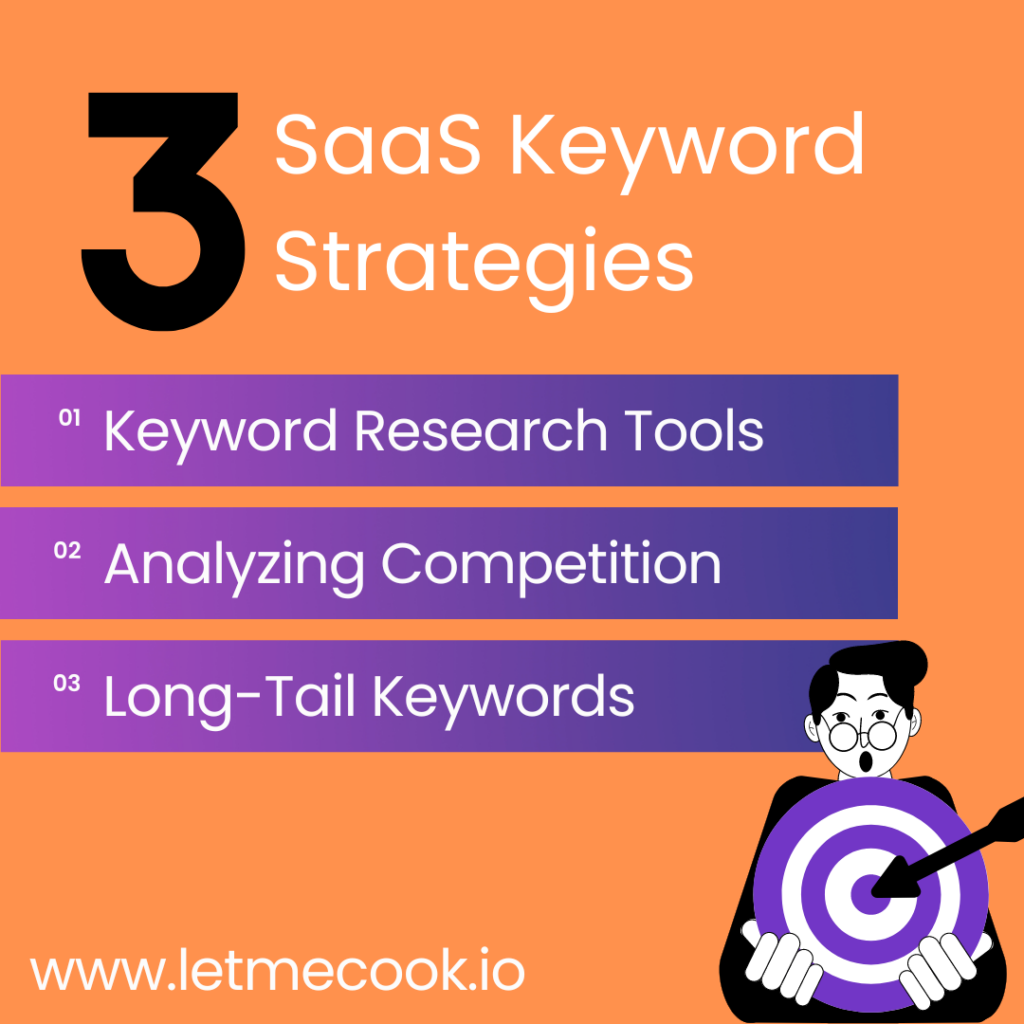This article contains affiliate links – but that doesn’t mean this piece is an ad.
All content is our honest take on the service/product and incorporates our
real thoughts and experience using it.
Content writing for SaaS is a bit harder than what many new businesses like to think. When writing a B2B SaaS marketing blog, several factors come into play. One of the most undervalued is keyword strategy.
There’s more to it than looking up a list on your favorite marketing software dashboard and going to town on random keywords.
It’s imperative to make your content stand out. Yes, you need to reach the right audience. But to do that, you have to do a couple of things right. Keyword research is where great content begins. That’s why nearly 80% of marketers in the B2B space employ it as part of their content strategy.
There’s nothing we love more than great content. This guide will provide you with the resources you need to master the art of SEO. We’ll show you how to capitalize on targeted keyword strategies.
From understanding the basics of SEO to demystifying keyword research – we’ve got you covered. You’ll learn to master on-page SEO essentials, create compelling content with SEO in mind, and adapt your strategies for maximum impact.
Pick up your instrument of choice. It’s time to rock.
Table of Contents
Content Writing for SaaS and Understanding the Basics of SEO
When it comes to content writing, understanding the basics of SEO will be your initial starting point.
SEO (Search Engine Optimization) refers to the process of structuring/optimizing your website and its content. The goal here is to make it easy for Google to find and rank your site.
Why Does SEO Matter?
Well, when potential customers search for solutions or information related to your business, you want your website and content to show up at the top of their search results.
That way, they are more likely to click on your link and visit your site, increasing your chances of converting them into a paying customer.
The Ranking Process

To achieve this, you need to understand the search engine ranking process and what factors they consider.
Factors that influence Google include things like website structure, keywords, quality of content, and backlinks.
However, most of these factors are out of your control. What you can control is what you do on your site. By optimizing those critical elements, your odds of showing up in the SERPs increase dramatically.
The Importance of Keyword Research for a B2B SaaS Marketing Blog
Now you know SEO’s role in content writing for a B2B SaaS marketing blog. Let’s dive into keyword research – one of the most critical aspects.
Keyword research involves finding the words and phrases that your target audience is using to search for information. Essentially, what are they typing into the search box?
By understanding the importance of these keywords, you can adapt your content to incorporate them strategically. This will increase the chances of ranking higher in search results.
This process also helps you gain a better understanding of your target audience’s pain points, needs, and interests, allowing you to create more relevant and valuable content.
Keyword Research Strategies for SaaS Marketing Blog Posts

Sure. You can jump in and generate a bunch of content, hoping to rank. But you won’t get very far.
You’re not writing a food diary on a free WordPress blog. This is your business.
You’ll need to implement the right strategies for your SaaS marketing blog posts to get the most bang for your buck. Check these out:
1. Use Keyword Research Tools
There are various keyword research tools available, such as LowFruits, SEMrush, and Google Keyword Planner. These tools help find the best keywords related to your industry and target audience.
2. Analyze Your Competitors
Another effective strategy is to scope out your competitor’s websites and see which keywords they are using. This can give you insights into what keywords are working for them and help you identify gaps in your keyword strategy.
The premium tools we mentioned in the first point can help you find the competition and the keywords they’re using.
3. Consider Long-Tail Keywords
Long-tail keywords are longer, more specific words or phrases people type into the search bar.
They may have less search volume than broad keywords, but they tend to be more targeted and have less competition. Including long-tail in your content can help you attract a more qualified audience.
Let’s say you sell tires. If you try to go after the keyword “tires”, you have no chance of ranking. All of the major players have that keyword on lock. Instead, go after long tails.
- Cheap tires for Honda Accords
- Best tires to put on a Tesla
- Top 5 tires for wintertime in Michigan
The Role of On-Page SEO
On-page SEO refers to different ways that you can structure and optimize each individual web page to improve search engine rankings.
This is where you’ll be focusing on the technical elements of your website. We’re talking title tags, meta descriptions, and header tags with relevant keywords.
Other on-page factors include page loading speed, mobile-friendliness, and internal linking.
Optimizing these elements tells search engines that your content is relevant and valuable. Making their bots happy increases your chances of ranking higher in search results.
Let’s get into them a bit more.
Title Tags/Permalinks
Title tags are the titles that appear at the top of your web browser when you visit a page.
They also show up as the clickable headline in search engine results. It’s essential to include your target keyword here.
Pro-tip: Try to keep it under 60 characters to avoid truncation.
Meta Descriptions
Meta descriptions are short snippets that show up in search results below the title tag. They provide a brief summary of what the page is about before the readers click the link.
Add relevant keywords in your meta description and keep it under 160 characters.
Header Tags/Styles
Header tags (styles such as H1, H2, and H3) are used to structure your content. This is used to make it easier for readers to navigate your posts.
Search engines also use header tags/styles, to understand how your content is organized. Including relevant keywords in your headers can help improve your SEO.
They’re also necessary for reading. No one wants to see a huge block of text. Headers help break up your content.
Alt Image Tags
Alt image tags describe images on your website for visually impaired users. But what most don’t know, is that search engines also use them to understand the content of an image and its relevance to the page and overall site.
If you’re including images in your B2B SaaS marketing blog posts (and we highly recommend you do), this is an easy way to assist your SEO efforts with little extra effort. Why? Because many people forget this extra step.
Pro-Tip: Include relevant keywords in your alt tags for SEO.
Page Loading Speed
Page loading speed refers to how quickly your website loads for a user.
You need a fast-loading website to rank well. It improves user experience and signals to search engines that your site is well-maintained and valuable.
You want to shoot for a loading time of under two seconds. The average speed of a site on the first page of the SERPs is 1.65 seconds.
Mobile-Friendliness
Having a mobile-friendly website is a big deal.
Why?
Google found that more people use their devices for searching than PCs. According to Statista, roughly half of all website traffic comes from a mobile device. So, Google made it a part of their algorithm and now prioritizes mobile-friendly sites.
Internal Linking
Linking to your own website content is called internal linking. But you can link to any page on your website that you think is relevant.
This not only helps readers navigate through your content but also signals to search engines that your site has valuable information and increases the chances of ranking higher in search results.
You want to put a focus on internal linking. They’re the best way to drive organic website traffic down the funnel towards more transactional content.
External Linking
Linking to a website that you don’t own is called external linking. Google wants to see this – because their users want to see it.
They want evidence that the facts and figures you state are well-researched and from reliable sources. It helps add credibility to your content and your company. And, credibility is liquid gold for your B2B SaaS marketing blog posts.

B2B SaaS Content Marketing Blog Writing Tips – Crafting Compelling Content With SEO in Mind
SEO. It’s important. It gets free traffic to your website. But only if your content is worth a ranking in the eyes of search engines. Here are some B2B SaaS content marketing blog writing tips to help make it happen.
1. Use Keywords Strategically
Relevant keywords improve your search engine ranking. But using them the wrong way can do more harm than good.
We’re talking about a tactic called “keyword stuffing”. It’s an old-school method many marketers deployed to try and trick search engines. It worked for years. It doesn’t anymore. So don’t do it.
Use keywords naturally and only when they make sense in the context of your content. Put your main keyword in your title, intro, a header, and sprinkle it around your content.
Secondary keywords should be randomly in headers and sprinkled as well, but not quite as heavily.
2. Write for Your Audience
While it’s essential to keep SEO in mind, remember that, ultimately, you are writing for your audience.
Focus on creating high-quality, valuable content that will resonate with them rather than solely trying to rank higher in search results.
Google is the top search engine for a reason. Their job is to curate content and present the best of what’s out there to people using their product. That’s basically what the SERPs do.
To maintain their standing as the best, they have to give people what they want. It all comes down to the audience. If Google thinks your audience will like your stuff, so will they, and you’ll be rewarded with rankings.
3. Use Relevant and Engaging Headlines
Your headlines are the first thing that readers see, so it’s crucial to make them engaging and relevant. This not only helps grab their attention but also gives Google a heads-up about the nature of the content.
4. Include Visuals
Visuals, such as images and videos, not only make your content more engaging but also help improve SEO.
Make sure to optimize your visuals by using keywords in file names and alt tags. Blog posts are a great place to embed your YouTube videos.
5. Update Your Content Regularly
Search engines prioritize fresh, up-to-date content, so it’s crucial to update your blog posts with new information or statistics regularly.
It helps improve your SEO and keeps your audience engaged and returning for more.
Measure and Adapt Your B2B SaaS Marketing Blog Posts
It’s important to measure and analyze your SEO efforts regularly, and consistently. This way, you can see what’s working and what needs improvement.
Use tools like Google Analytics or the ones mentioned above to track your website traffic and keyword rankings. This will help you understand which keywords drive the most traffic to your site, allowing you to adapt your strategy accordingly.
While this blog post, and any blog post for that matter, is linear, the process is not. It’s cyclical.
Round and round she goes.
Your digital marketing strategy must adjust to changes in SEO and Google’s algorithm, customer preferences, and the overall SaaS market.
Your B2B SaaS Marketing Blog – Master the Art of Content and SEO for Long-Term Prosperity
SEO and keyword strategy are integral aspects of crafting compelling blog posts for your B2B SaaS marketing blog. But content writing for SaaS websites is only one piece of the puzzle.
A well-planned strategy involves identifying and utilizing the right keywords, keeping an eye on your competitors, and considering long-tail keywords.
Equally important is on-page SEO, including optimizing title tags, meta descriptions, and header tags, improving page loading speed, ensuring mobile-friendliness, and adopting effective internal linking.
Remember, the key isn’t just about ranking higher in search results but producing high-quality, valuable SaaS marketing blog posts that resonate with your audience.
Regular measurement and analysis of your SEO efforts are also crucial for continuous improvement and success.
Using our B2B SaaS content marketing blog writing tips can enhance your visibility. You’ll drive more traffic and grow your SaaS company organically.





Your article helped me a lot, is there any more related content? Thanks!
Happy to hear that! You should check out our on-page and off-page SEO articles.
Very informative article and interesting SEO strategy.
Blogs are a great way to drive organic traffic if done right, especially in the age of AI. Having a strategy is step #1.